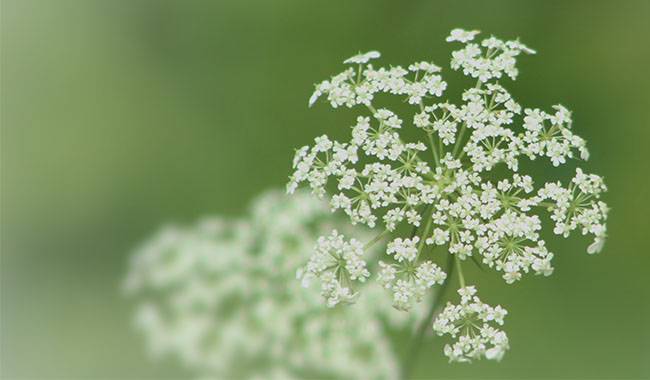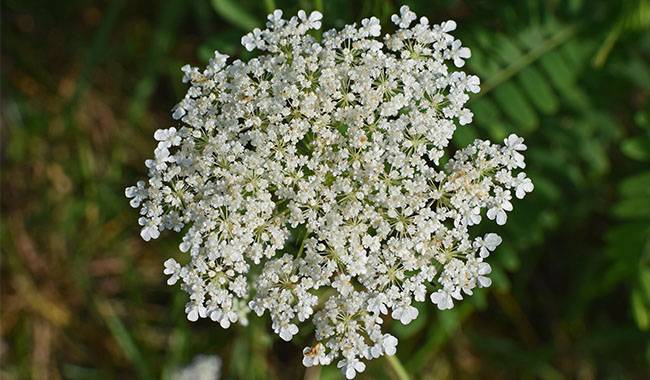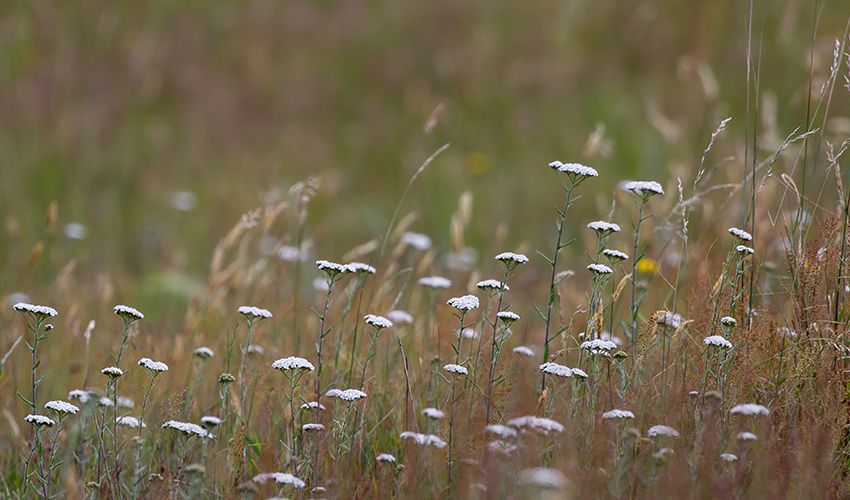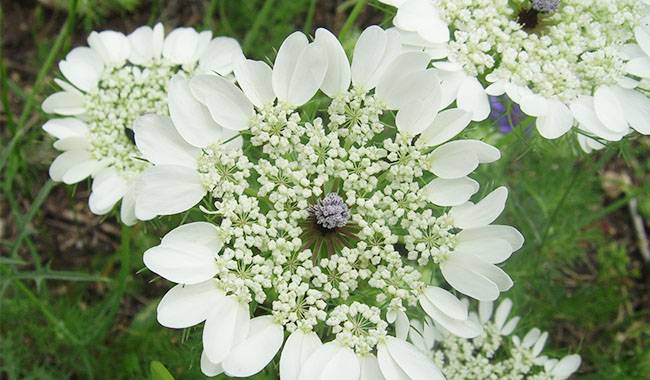
Ammi majus, also known as Queen Anne’s lace, can be grown as an annual or biennial plant. It belongs to the Umbelliferae family and has good taproots, bare sturdy stems, and pinnately dissected, lance-shaped leaves. So how to grow Ammi majus? This article provides answers for planting as well as care.
Ammi majus has small, unattractive, and light-colored flowers. They are collected in umbels up to a few inches in diameter. the flowering period is from midsummer to early autumn. The fruits are slightly flattened, side-viewing fruits without anything covering them and smooth. They are quite small, measuring only two and a half millimeters. They ripen in mid-autumn.
INFORMATION ABOUT AMMI MAJUS
Ammi majus is a small genus of the Umbelliferae family. It consists of six species of one- and two-year-old herbs native to the Mediterranean coast as well as northern Africa.
Ammi majus has a taproot and an erect, branched stem. The lower leaves are long-petiolate and the upper leaves are short-petiolate. The rich green leaves are dissected into 2-3 tiny lobes. The leaf margin is sharply serrate.
Ammi majus flowers from midsummer to autumn. Small white flowers with five small petals are gathered in large compound inflorescences. The peculiar smell attracts insects, including bees. The honey is fragrant and slightly red in color.
After flowering, the fruits appear as laterally flattened, lamellar fruits. They look very attractive and split into two lobes when ripe.
BENEFITS OF AMMI MAJUS
Ammi majus belongs to the category of medicinal plants. It has been used for medicinal purposes since ancient times. Today, it is known for its medicinal value.
Urinary tract.
Leucoderma.
Digestive organs.
Colds.
The plant contains essential oil with the following valuable components.
bergapten.
Aflatoxin.
Royaltyin.
Isopirin.
Flavonoids.
Fatty oils.
Great importance is attached to the medicinal properties of the substance flavopiridol. It has very good properties in restoring skin pigmentation. Therefore, it is an indispensable plant in the manufacture of drugs for the treatment of vitiligo (leukoderma), alopecia, psoriasis, erysipelas, neurodermatitis.
Ammi majus bioactive components in the fine vessels strengthen and regulate the uterus and intestines. It includes preparations of Ammi majus, used as choline, diuretic, and sedative.
In nature, Ammi majus is distributed in southern and southeastern Europe, North Africa, the Near and Middle East, Russia, and Ukraine.
Today, the plant is successfully cultivated on an industrial scale.
HOW TO GROW AMMI MAJUS
There are two varieties of farm-grown Ammi majus – large and toothed. The plants are large, but not bulky. The openwork “airy” leaves accentuate the decorative nature of the inflorescence. Ammi majus is excellent for cutting and stays fresh for a week. Great on its own as a bouquet or as a backdrop for other flowers.
Ammi majus is completely undemanding, grows in any soil, and is not attacked by pests. Recommended for planting as an annual. The abundant fruit provides planting material for homeowners.
The fruits of the plant contain medicinal substances. Even ancient Egypt with their help tried to fight diseases such as vitiligo, psoriasis, erysipelas. Today, the cultivation of medicinal Ammi majus on a commercial scale is underway.
Medicines (pills, ointments) are produced by well-known pharmaceutical companies. However, self-medication with infusions and decoctions is fraught with serious problems. In fact, there are many contraindications and side effects.
Therefore, it is better to grow Ammi majus exclusively as decoration in gardens and balconies and enjoy the beauty of the plant.
CULTIVATION OF AMMI MAJUS
Ammi medicines can be cultivated perfectly as a cultivated plant. It is very simple and unpretentious. However, there are some conditions to get good results.
So, the soil for growing Ammi majus should be black and clean, and weed-free. It can be planted on plots that have previously been planted with cereal crops, early vegetables, and medicinal plants: chamomile and poppy oil seeds.
Before planting, the soil should be prepared.
- cleaning the residues of previous crops.
- to plow.
- to make plowing and harrowing.
All the above actions are combined with soil fertilization. Before deep plowing, it is necessary to apply the following nutrient mixtures on a per hectare basis.
- ammonium sulfate: 2.5 grams.
- superphosphate: 3.5 g.
- ammonium nitrate: 1.5 g.
Before sowing in spring combine the introduction of potassium chloride (50 kg), superphosphate (300 kg), and ammonium nitrate (100 kg) per hectare of soil.
Then, for maximum effect, the sowing should be combined with the application of calcium superphosphate to the soil. This will improve the germination of seeds and increase the yield by up to 35% (seed harvest).
And in the cultivation of Ammi majus, the last application of fertilizer is made at the vegetative stage when the seedlings form about six leaves. At this stage, ammonium nitrate is applied. However, an important condition for fertilization is soil moisture, which must be at least 20%. If, for example, it is impossible to irrigate the site and it has not rained for a long time, but it is better not to do ammonium nitrate.
Ammi majus can be sown with both spring and winter under the ground. It should be noted that it is better to carry out spring planting. To improve the germination of seeds, they are stratified for three months. The seeds are then dried and sieved. Another preparation step is to soak the seeds in water for one day before sowing. Floating sowing is not suitable.
Ammi majus is sown with a disk seeder to a depth of 1inch (2 cm). The sowing rate was 5 kg for a one-hectare plot. Under favorable weather conditions, the first shoots appear after two weeks.
Fall sowing requires increasing the seeding rate to 6 kg and reducing the burial depth to 0.6inch (1.5 cm). Otherwise, the planting technique is the same.
Ammi majus is planted on cultivated land and requires certain human actions to take care of the crop.
The main task is loosening the soil and timely removal of weeds. For this purpose, it is necessary to carry out inter-row clearance of weeds with a special cultivator. During the whole period of formation of the ground part, as a rule, three to four cultivations are carried out.
Weeds in the rows are removed by hand. This work should be done at least twice and should be combined with thinning work. If the seedlings are too thick, the yield will be significantly reduced. The first weeding is done to thin the shoots when Ammi majus is still small and has two leaves.
The seeds are used for medicinal purposes. Therefore, a large collection of this material is grown on an industrial scale Ammi majus large.
The seeds are harvested when the percentage of maturity exceeds sixty percent. This is done mechanically, with the help of a combined harvester specially equipped for this purpose. The harvested crop is dried and cleaned.
The yield of this medicinal plant is not very high, with an average of about ten hundred pounds of seeds per hectare. The storage and use period of the medicinal herb depends on the storage conditions and is 3-10 years.
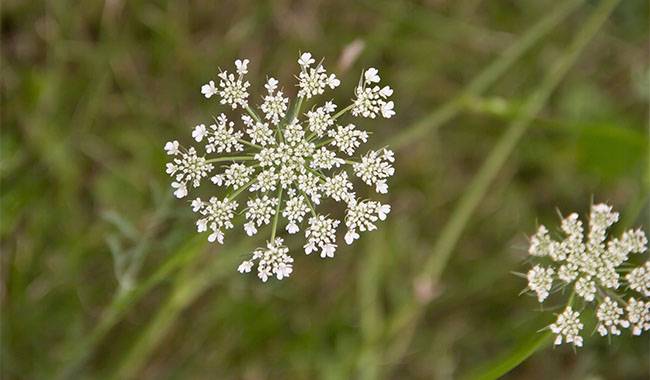
THE FIRST STEP AFTER PURCHASING SEEDS
Ammi majus is grown from seeds. They remain germinating for 3-4 years, which should be noted at the time of purchase.
In areas with relatively warm winters, it is recommended to sow seeds under winter. In areas with more severe climatic conditions, spring sowing is done. The optimum soil temperature is 43-46°F (6-8°C). Seedlings emerge in 1.5 to 2 weeks. Seedlings grow unhurriedly at first. But after the tillering stage, they actively increase in height and width.
To advance the flowering time helps to raise seedlings in February-March. It is advisable to stratify seeds for a month. Bury them in the nutrient substrate 0.8inch (2 cm), moisten the soil and cover it with glass or polyethylene.
Place the container in a warm place until sprouts appear. Sprouts need plenty of light, but the night air temperature should not exceed 53-59°F (12-15°C). Otherwise, seedlings will stretch disproportionately.
Seedlings can be moved to designated locations by the end of May. Given the fragility of the root system, great care should be taken when transplanting so as not to damage the ground nodules.
RECIPE FOR SUCCESS
Ammi majus grows well in full sun and semi-shade. Any garden soil is suitable, just take care of a good and reliable drainage layer.
In case of open sowing, it is recommended to add organic fertilizer to the soil beforehand. The seedlings are planted with two applications of complex mineral fertilizer.
Ammi majus is drought tolerant but needs regular and moderate watering in the early stages of growth and in hot weather. Temperature and water characteristics are not important.
The plants respond thankfully to weeding and loosening of the soil.
POSSIBLE DIFFICULTIES
Ammi majus suffers from waterlogging in the soil. The root system rots rapidly and the plant dies. Lowland areas are considered unsuitable for maintaining representatives of this flora. The soil is watered only after it has dried out.
In the absence of light, the stems increase in height and density, but flowering becomes sparse. There is a possibility of not producing fruits. High air humidity during flowering will have the same effect.
Ammi majus are tall plants with many branches. If they do not have enough space, they will become smaller and weaker.
CARE AND HARVESTING
Ammi majus crop care includes systematic loosening of the soil between the rows and the plants do not receive compaction. As two true leaves appear on the shoots, they are thinned out. During drought, at the beginning of cultivation – watering every 2-3 days. During flowering, watering is reduced.
Harvesting of Ammi majus takes place during the period of massive seed maturity when most of the umbels curl and the stems turn yellowish. After harvesting, Ammi majus fruits are dried and peeled.




